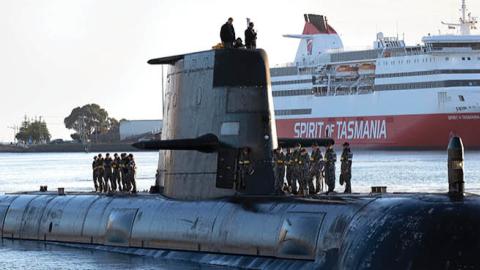Henry Kissinger thought in triangles. His strategic triangle featured the United States, the Soviet Union, and China. Today, there is a new strategic triangle in the Indo-Pacific. Its apex is in Canberra, with one leg running northwest to New Delhi and the other running north-south from Tokyo to Canberra. Two other important strategic lines extend from Washington, D.C., and now from London.
This reality has been evolving slowly since 2007 in response to the myriad challenges posed by an increasingly assertive China. In part, it reflects uncertainties about U.S. commitment and leadership dating at least from President Barack Obama’s retreat from his “red line” in Syria and President Donald Trump’s transactional approach to alliances. It also reflects a consequent recognition by Japan, Australia, and India of the need to assume greater roles in strengthening the region’s security architecture.
The evolution of the Indo-Pacific security structure, from the Cold War “Hub and Spokes” model to more networked comprehensive architecture, has featured growing security relationships among Australia, India, and Japan. This new structure also includes their development of strategic partnerships with Indonesia, Singapore, and Vietnam, among others. Meanwhile, Australia, India, and Japan continue to strengthen bilateral alliances with the United States and expand security ties with regional powers outside the region, as reflected in the AUKUS submarine deal.
The Indo-Pacific Triangle
The trend toward increasing triangular cooperation can be glimpsed in the development of the Australia-India leg of the Indo-Pacific strategic triangle. Australia’s 2017 Foreign Policy White Paper,is%20our%20agenda%20for%20opportunity%2C%20security%20and%20strength. identified India as a key security partner in support of regional order. The AUSINDEX exercises began in 2015, most recently conducted in September 2021 off the coast of Darwin, Australia.
In a June 2020 virtual Summit, Prime Ministers Scott Morrison and Narendra Modi elevated the 2009 Strategic Partnership to a Comprehensive Strategic Partnership, marked by a shared “vision of an open, free, rules-based Indo-Pacific” to be advanced by cooperation in the maritime domain. The prime ministers also agreed to a mutual logistics support agreement, providing for reciprocal access to Australian and Indian military bases. Following the summit, New Delhi invited Australia to join India, the United States, and Japan in the 2020 Malabar exercise, the first time that members of the Quad exercised together. On September 10-12, 2021, the first 2+2 Ministerial Level of the Comprehensive Strategic Partnership was held in New Delhi. Both India and Australia sent their foreign ministers and defense ministers to the meeting.
The India-Japan relationship, dating from the arrival of Buddhist monks in Japan in the sixth century, has, in the twenty-first century, evolved into a Special Strategic and Global Partnership. Modi and former Japanese Prime Minister Shizo Abe have been instrumental in the development of this expanding relationship. Abe set out an early vision of what evolved into a mutually shared vision of a Free and Open Indo-Pacific in a 2007 address to India’s Parliament. In his remarks, “ The Confluence of the Two Seas, ” Abe observed that, as maritime countries, Japan and India “have vital interest in the security of the sea lanes.” He called on Indian and Japanese diplomats and defense officials to “consider jointly” the future of security cooperation.
Japan then joined the India-U.S. Malabar exercise in 2015 as a permanent exercise partner. The Japan-India exercise JIMEX began in 2016 in the Bay of Bengal and has continued on an annual basis. In September 2020, India and Japan concluded an acquisition and cross-Servicing agreement, opening the door to expanding security cooperation. In June 2021, Japan and India conducted a bilateral exercise in the Indian Ocean in support of a Free and Open Indo-Pacific. Today, annual summits mark the relationship supported by a 2+2 annual meeting of foreign and defense ministers
The twenty-first-century Japan-Australia relationship is framed by the 2007 Joint Declaration on Security Cooperation, which provided for “consultations on issues of common strategic interest in the Asia-Pacific region and beyond,” including the exchange of defense personnel, joint exercises, and the establishment of a 2+2 mechanism. In 2013 Japan and Australia concluded an acquisition and cross-servicing agreement and an information security agreement to advance defense cooperation. Canberra and Tokyo elevated the bilateral relationship to that of a Special Strategic Partnership in 2014.
Australia’s 2017 Foreign Policy White Paper,is%20our%20agenda%20for%20opportunity%2C%20security%20and%20strength. welcomed Japan’s defense reforms and growing defense capabilities and expressed support for a Japan that “will play a more active role in the security of the region.” Japan joined the Australia-U.S. exercise Talisman Sabre for the first time in 2019, dispatching the helicopter carrier Ise and 500 Self-Defense Force personnel. Underscoring the expanding Japan-Australia defense relationship, the two governments in November 2020 concluded a Reciprocal Access (Status of Forces) Agreement. Prime Minister Yoshihide Suga welcomed the agreement as a sign of a shared “will and capacity to contribute to regional peace and security. Morrison hailed it as “a landmark defense treaty” enhancing the Australia-Japan “special strategic partnership.” In remarks prior to the June 2021 2+2 meeting, Reuters reported Japan’s Foreign Minister Toshimitsu Motegi as saying that he wanted to take the Japan-Australia security relationship to “new levels.”
Free and Open Indo Pacific
As the triangle has evolved over the past decade, Japan, Australia, and India have moved to strengthen ties with the United States and, in response to the multifaceted challenges posed by an increasingly assertive China, to join forces in support of a Free and Open Indo-Pacific.
The Joint Statement of the 2019 U.S.-Japan Security Consultative Committee marked the alignment of U.S. and Japanese security policy documents and expressed concern that “coercive attempts to undermine international, rules, norms, and institutions present challenges to the Alliance and the shared vision of a free and open Indo-Pacific.” Similarly, the 2020 Joint Statement of the Australia-U.S. Ministerial Consultations set the Indo-Pacific as “the focus of the alliance” and committed the alliance partners to working “side-by-side” with the Association of Southeast Asian Nations, India, Japan, and the Republic of Korea to “strengthen our networked structure of alliances and partnerships to maintain a region that is secure, prosperous, inclusive, and rules-based.”
In February 2020, during Trump’s visit to India, a Comprehensive Global Strategic Partnership was agreed to. Later, in an October 2020 U.S.-India 2+2 meeting, the governments agreed to a Logistics Exchange Memorandum of Agreement, a Communications Compatibility and Security Agreement, and a General Security of Military Information Agreement. They also reiterated their commitment to a free and open Indo-Pacific governed by the rule of law.
Now a second strategic line to the Indo-Pacific triangle is emerging—from London. The recent deployment of the HMS Queen Elizabeth carrier strike group to the Indo Pacific, the decision to deploy two off-shore patrol boats to the region, and the recent AUKUS nuclear submarine deal speak to London’s intention to maintain, in the words of Defense Minister Penny Mordant at the 2019 Shangri-la dialogue, a “persistent” presence in the region.
The modern strategic geometry of the Australia-India-Japan triangle, joined by the United States in the Quad, represents a shared vision of a Free and Open Indo-Pacific. It supports a rules-based order, peaceful resolution of disputes, and opposition to coercion or force to effect unilateral change in the status quo. Are there differences among them with respect to China? Yes, unquestionably, interests, shaped by geography and economics, are not identical. But with respect to the Indo-Pacific, these countries are mutually reinforcing. Going forward, it will be the task of political leadership in Washington, Tokyo, Canberra, and New Delhi to narrow differences and, at the same time, coordinate and integrate national policies toward the realization of their collective vision.
Read in National Interest

















